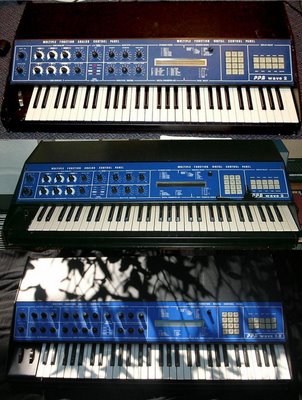
This one in via Nikos:
"PPG front panel differences:
In the picture, the 2 upper photos are the PPG Wave 2.0: as you examine the front panels you'll find differences:
The upper one (which I call the first version because it was used for the original brochure) has no space between top legending and top flat panel. Also the legending around the LCD screen has a different configuration, compare with the second version. That usually had Moog type- chrome topped knobs, here in the pic has the standard PPG type. The second version which is more common, has a space between top flat panel and upper legend. To be more confusing, I've seen sec. ver. Wave 2.0's with chrome topped knobs! Also in the second the legending around the screen has the same configuration with the later Waves (2.2 , 2.3). Also, the top writing 'Multiple digital/analog control panel' has different placement and font size in all versions (2.0a, 2.0b) and in the 2.2/2.3 is on it's final placement. The later versions (2.2 / 2.3) had no differences between them anyway, and both had standard pitch/mod wheels, compared with the wave 2.0 single wheel with it's strange ergonomic angle - I can't tell if it's more comfortable than the usual placement - better ask a wave 2.0 owner!
A curious thing is that in almost every Wave 2.0 I've seen, the front panel paint is worn, mostly in the volume knob area and the programmer's numerical switches area. This problem is not common in later waves -maybe they improved the front's panel paint quality/sturdiness. It is reported that only 200 2.0's were made (both versions).
The main internal difference, apart from the single oscillator per voice in the 2.0, is that the filter chip was the CEM 3320 -in the Wave 2.2/2.3's used the SSM 2044 of course. As for the VCA's, in the 2.0 used the CEM 3330 (dual VCA) and in the 2.2/2.3 the VCA chip was the CEM 3360 dual VCA as well.This info is backed by service literature. Sound wise, the 2.0 was more rawer and primitive than the 2.2/2.3's, although the INTERNAL wavetable resolution in ALL Waves, was 8-bit. Things were different in 2.3's, where it had SRAM of 12-bit and thus you could play samples from Waveterm B loaded into the 2.3.
 Edgar Froese of Tangerine Dream and Klaus Schulze both had the first version of Wave 2.0 and used them 'till 1983 as far as I know. In fact, E. Froese's is visible in his rig in the 'Poland' video (1983 - left) and Klaus Schulze had his own Wave 2.0 with him, when he toured Poland in 1983. You can have a very good idea how well the Wave 2.0 by listening to track 'Remote Viewing' by Tangerine Dream, from the 'Exit' LP, from the middle and on there some melodies played by Froese on the Wave 2.0 with a voice-like patch,gritty, beautiful and majestic.
Edgar Froese of Tangerine Dream and Klaus Schulze both had the first version of Wave 2.0 and used them 'till 1983 as far as I know. In fact, E. Froese's is visible in his rig in the 'Poland' video (1983 - left) and Klaus Schulze had his own Wave 2.0 with him, when he toured Poland in 1983. You can have a very good idea how well the Wave 2.0 by listening to track 'Remote Viewing' by Tangerine Dream, from the 'Exit' LP, from the middle and on there some melodies played by Froese on the Wave 2.0 with a voice-like patch,gritty, beautiful and majestic. PPG photos credits: top photo from ebay auction, second by Laurent Prot from Paul Maddox PPG CD-ROM, the 3d by a 'Matrixsynth' link and Edgar Froese's pic is a capture from the 'Poland' video.
That's about now,
Long live the Wave.
Nick-Greece"





































Very interesting. Thank you.
ReplyDeleteFwiw, inside there can be other differences in the power supplies, displays and panel boards too.
Some waves used keyboards other than Pratt-Read also.
Hello Kevin,
ReplyDeletehave ever worked on a Wave 2.0?
Nick-Greece
the 2.0 has a different way of stepping through the wavetable across pitchs. The 2.2/2.3 adopt a NCO phase accumulator design whereas 2.0 has master clock (variable sample rate) a VCO with each voice dividing to the pitch req'd cf. divide-down electronic organs. The 2.0 can sound more like a tape machine, the 2.2/2.3 still do too, but the 2.0 has a more 'tape' like sound with respect to pitch. Later evocations of the design by Waldorf on a ASIC (DSP) the Microwave 1/Wave adopt interpolation methods.
ReplyDeleteWhy was phase accumulator necessary? Well to get you to 2 Osc per voice, the 2.0 only has 1 osc.